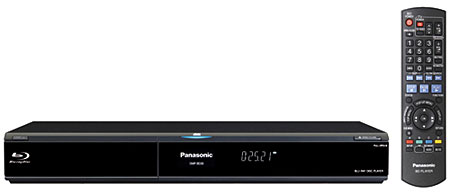Panasonic DMP-BD30 Blu-ray Player

The new DMP-BD30, however, not only carries a significantly lower price tag ($499), but is a completely new design as well. In one important way it takes us closer to the ideal feature set that should have been designed into Blu-ray players in the first place. In another respect, however, it takes a step backward.
Would You Like Cream and Sugar
BD-Java is the platform that the Blu-ray group chose for authoring the format's advanced interactivity, such as active menus, picture-in-picture for on-screen commentaries, Internet interoperability, etc. BD-J is touted as being more powerful and scalable (for possible future developments) than HDi, which the HD DVD group chose to author both the basic content and advanced interactivity of its discs. But BD-J is also considerably more complex and, to date, less thoroughly implemented and more trouble-prone on early BD players.
That complexity may be the main reason that, up to now, we have not seen Blu-ray Discs with the advanced interactivity described above, nor standalone BD players that meet the hardware requirements necessary to play them back (we specify standalone players here because Sony's PlayStation3 game console/BD player does meet the hardware requirements for BD-Rom Profile 1.1 and 2, and a firmware update for 1.1 features is imminent as we write this). And in players without those capabilities, we're seeing serious loading delays and other problems in a growing number of new BD discs, such as the Pirates of the Caribbean releases and the new Pixar BDs, including both Cars and Ratatouille.
The DMP-BD-30 is the first player to market that complies with BD-ROM Profile 1.1 hardware requirements. There are three current BD-ROM Profiles as they are formally called. Profile 1.0 is found in every other BD player released to date. With 64K of local storage (persistent memory), these players are woefully unprepared for new BD-J features. Profile 1.1 requires a minimum of 256MB of local storage and secondary audio and decoders for streaming Picture-In-Picture features and the like.
Note also that while Profile 1.1 is called the "Final Standard [BD-ROM] Profile" in Panasonic's promotional materials, that does not mean that it's the last current word BD hardware. For now, that's Profile 2.0 (BD-Live), which requires 1GB of local storage plus network capability (likely in the form of an Ethernet or LAN port). No player currently offers BD-ROM Profile 2.0, but again, the PS3 meets the hardware requirements and is likely to be upgradeable to meet this spec.
The "local storage" does not need to be internal. A removable vehicle such as a flash drive or memory card can provide it.
The Panasonic does have an SD card port, which may be used for the onboard memory required for some future disc features (see more on the SD card feature below). But it lacks an Ethernet port for Internet interactivity (not to mention direct downloading of firmware upgrades), so will never be upgradeable to Profile 2.0. But BD-ROM 1.1 is long overdue, and welcome with discs already announced with advanced interactivity for these new players to take advantage of.
The Old Bitstream
Up until recently, the only way you could hear the new, lossless Dolby TrueHD audio format from a BD (or HD DVD) was for the player to decode it to multichannel PCM and pass that along to the receiver or pre-pro either as HDMI digital audio or via the player's multichannel analog outputs. Most receivers produced over the past couple of years will accept and play multichannel PCM over HDMI, but not all.
No player up to now could decode lossless DTS-HD Master Audio. They could only extract the core, lossy 1.5Mb/sec DTS track and pass that to the receiver, either over HDMI or multichannel analog.
The Panasonic is the first player that can retrieve full resolution TrueHD and DTS-HD Master Audio from a disc and pass them to a receiver in native bitstream form.
But Panasonic giveth and Panasonic taketh away. The DMP-BD30 lacks any internal capability to decode TrueHD, much less DTS-HD MA. What this means is that the only way you'll hear either format in true lossless form from this player is if you have a new AV receiver or pre-pro that can decode it from a native bitstream. This means only certain receivers released to market since mid 2007 need apply; decoding of TrueHD and DTS-HD Master Audio bitstreams has only recently begun showing up in most new receivers, but it's still as rare as raptors' teeth in pre-pros.
If you have an older receiver that cannot decode either new format, the only audio you will hear from the DMP-BD30, regardless of the pedigree of the selected soundtrack, will be straight Dolby Digital or DTS. It may arrive at the receiver in either PCM or bitstream digital form, depending on how the player is set up, or from the multichannel analog outputs, but in all such cases the limitation will be the same. On the upside, this audio will usually be at a higher data rate than is possible with the Dolby Digital or DTS available on DVD, and thus might well sound better. But it will not be lossless.
- Log in or register to post comments
























































